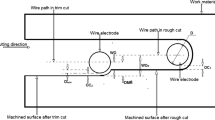Abstract
Low-speed wire electrical discharge machining (LS-WEDM) is an effective alternative to manufacture intricate shapes with high accuracy in difficult-to-machine materials like TC2 (Ti–3Al–1.5Mn). This paper aims to study the dimensional accuracy and surface quality of TC2 workpiece machined by LS-WEDM based on multiple cuts including rough and trim cuts. First, an orthogonal experiment L16 (54) is designed to evaluate the main influencing factors on surface roughness and machining time. Second, the optimum parametric settings for multiple cuts are designed, and the experimental work has demonstrated that the acute angle convex corners machined by LS-WEDM are accompanied with bending angles and the bending direction is opposite to the wire electrode movement, but the obtuse angle does not appear this phenomenon. Moreover, the wire deflection model based on the unilateral discharge mechanism is built to improve the machining accuracy. In addition, by comparing with the kerf and the surface microstructure of rough and trim cuts, the kerf consistency is improved obviously; the craters, cracks, voids and spherical droplets are gradually becoming much smaller size; the 3D surface parameters including Sa, Sq, Sy and Sz are greatly decreased. Eventually, the elongated craters and the overlapping convex peaks are discovered on TC2 workpiece surface.






















Similar content being viewed by others
References
Mahapatra SS, Patnaik A (2007) Optimization of wire electrical discharge machining (WEDM) process parameters using Taguchi method. Int J Adv Manuf Technol 34:911–925
Ikram A et al (2013) Parametric optimization for surface roughness, kerf and MRR in wire electrical discharge machining (WEDM) using Taguchi design of experiment. J Mech Sci Technol 27(7):2133–2141
Mohammadi A et al (2008) Statistical analysis of wire electrical discharge turning on material removal rate. J Mater Process Technol 205:283–289
Ezugwu EO, Wang ZM (1997) Titanium alloys and their machinability—a review. J Mater Process Technol 68:262–274
Hascalık A, Caydas U (2007) Electrical discharge machining of titanium alloy (Ti–6Al–4V). Appl Surf Sci 253:9007–9016
Kuriachen B, Somashekhar KP, Mathew J (2015) Multiresponse optimization of micro-wire electrical discharge machining process. Int J Adv Manuf Technol 76:91–104
Pasam VK et al (2010) Optimizing surface finish in WEDM using the Taguchi parameter design method. J Braz Soc Mech Sci Eng 2:107–113
Kuriakose S, Shunmugam MS (2004) Characteristics of wire-electro discharge machined Ti6Al4V surface. Mater Lett 58:2231–2237
Ghodsiyeh D, Golshan A, Izman S (2014) Multi-objective process optimization of wire electrical discharge machining based on response surface methodology. J Braz Soc Mech Sci Eng 36:301–313
Saedona JB et al (2014) Multi-objective optimization of titanium alloy through orthogonal. Procedia Technol 15:833–841
Dekeyser WL, Snoeys R (1989) Geometrical accuracy of wire-EDM. In: 9th international symposium for electro machining (ISEM-9), Japan, pp 226–232
Obara H et al (2003) Combined power and path control method to improve corner accuracy of rough cuts by wire EDM (1st report). Int J Electr Mach 8:27–32
Han F, Zhang J, Soichiro I (2007) Corner error simulation of rough cut in wire EDM. Precis Eng 31(4):331–336
Puri AB, Bhattacharyya B (2003) An analysis and optimization of the geometrical inaccuracy due to wire lag phenomenon in WEDM. Int J Mach Tools Manuf 43:151–159
Betrami I, Bertholds A, Dauw D (1996) A simplified post process for wire cut EDM. J Mater Process Technol 58:385–389
Zhang G et al (2014) A macroscopic mechanical model of wire electrode deflection considering temperature in cerement in MS-WEDM process. Int J Mach Tools Manuf 78:41–53
Ding JS (2011) Electrical discharge machining theoretical basis. National Defense Industry Press, Beijing, pp 52–53
Goswami A, Kumar J (2014) Investigation of surface integrity, material removal rate and wire wear ratio for WEDM of Nimonic 80A alloy using GRA and Taguchi method. Eng Sci Technol Int J 17:173–184
Aghaie AZ, Rahimi AB, Akbarzadeh A (2015) A general optimized geometry of angled ribs for enhancing the thermo-hydraulic behavior of a solar air heater channel—a Taguchi approach. Renew Energy 83(2015):47–54
Dodun O et al (2009) Using wire electrical discharge machining for improved corner cutting accuracy of thin parts. Int J Adv Manuf Technol 41:858–864
Fan S-Y et al (2013) Nonlinear dynamics analysis of multi-cutting wire electrode in WEDM-HS subjected to working fluid considering the effect of debris. J Mech Sci Technol 27(12):3595–3605
Weingartner E, Wegener K, Kuster F (2013) Influence of workpiece circumferential speed in wire electrical discharge machining. Procedia CIRP 6:238–243
Acknowledgments
The authors would like to thank the support of National Natural Science Foundation of China (No. 50175064) and the National Natural Science Fund for Young Scholars of China (No. 51205053).
Author information
Authors and Affiliations
Corresponding author
Additional information
Technical Editor: Márcio Bacci da Silva.
Rights and permissions
About this article
Cite this article
Gong, Y.D., Sun, Y., Wen, X.L. et al. Experimental study on accuracy and surface quality of TC2 in LS-WEDM multiple cuts. J Braz. Soc. Mech. Sci. Eng. 38, 2421–2433 (2016). https://doi.org/10.1007/s40430-016-0513-y
Received:
Accepted:
Published:
Issue Date:
DOI: https://doi.org/10.1007/s40430-016-0513-y



